Did Army Use Special Mind Voodoo To Trick Hippie Senators Into Funding War?

I do not even know where to start with this one: “The U.S. Army illegally ordered a team of soldiers specializing in ‘psychological operations’ to manipulate visiting American senators into providing more troops and funding for the war, Rolling Stone has learned — and when an officer tried to stop the operation, he was railroaded by military investigators.”
This Is What You Get
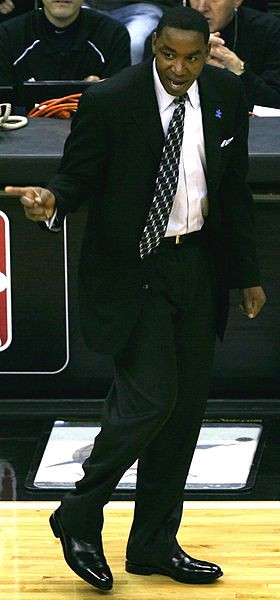
Even before his disgrace, Isiah Thomas was a strange and complicated case. A product of Chicago’s most blighted and Candyman-afflicted ruins, Thomas became a star at a Catholic high school in the suburbs. He survived two years of bellowing abasement at the hands of noxious windbreaker aficionado and total psychopath Bobby Knight at Indiana University, graduating to the NBA with a dazzling and idiosyncratic game, then went on to make a dozen All-Star teams and win a pair of NBA Championships with the Detroit Pistons. All of which is actually a pretty conventional, if obviously rarified, narrative. What made Thomas weird, then, was around the edges — the too-fulsome smile beaming from his boyish face from beneath those amused, long-lashed eyes; the weirdly wry and distant way that he played at saying very controversial things; the bizarre cheek-kisses he swapped with Magic Johnson before games. In his post-playing life in basketball, though, Thomas has not been successful or idiosyncratic or anything else so much as he has been stubborn, and wrong.
Thomas bought the Continental Basketball Association (the entire thing), which was once a thriving basketball minor league, and sunk it into bankruptcy in less than three years. He washed out of coaching and executive jobs in Toronto and Indiana, surfing blithely from both on tsunami surges of bad vibes, that same grin glowing warmthlessly from a face that somehow only grew more taut as he aged. When Zeke caught on with the New York Knicks in 2003, it was as the chief executive for a team that had the league’s highest payroll and second-worst record, and a roster that was bloated with sour-faced, underperforming veterans. During his five years with the Knicks, Thomas did two notable things — he consolidated power within the organization such that he was the team’s president, de facto GM and coach, and he made a lousy organization incalculably worse. The individual mistakes and globalized incompetence — the anchor-around-the-ankle contracts issued to marginal free agents and the tumid paranoia of Thomas’s handsy, creepy, flubby front office — are their own story, but also so numerous, numinous and deadening as to be besides the point. Suffice to say that Thomas did not so much steer the Knicks off a cliff as steer them off a cliff and into the mouth of a waiting sea monster, which sea monster was then served with a lawsuit, and then got cancer and died.
So, why talk about Thomas, given that he hasn’t worked for the Knicks since April of 2008 and is currently coaching the Florida International University’s Golden Panthers (to a 9–17 record)? Mostly because of Yahoo sportswriter Adrian Wojnarowski, who has written some scabrous pieces recently about Thomas and his enduring and inexplicable and seemingly growing influence in the New York Knicks’ front office. The pieces are oddly and dishearteningly believable, and are doubly so in the wake of the trade that the Knicks made for Carmelo Anthony on Monday, which was a notably and suspiciously Isiah-ish move that saw the Knicks deal three moderately priced young starters, a comic Russian and a raft of draft picks — the last bit being a particularly Zeke-y flourish — for the opportunity to pay a brand-name star extravagantly well, irrespective of how well that brand-name star does or doesn’t fit into the team’s style of play, personality, or whatever else. Given that Thomas was prone to this sort of thing during his tenure — he built rosters as if putting together fantasy basketball team that was three years out of date — and that this year’s Knicks turnaround is generally seen as the result of new team president Donnie Walsh doing the exact opposite thing for two painstaking years, it’s easy to see Thomas’s clammy hands all over the Carmelo trade. (That the New Jersey Nets, who were also rumored to be in on the trade, turned around and made their own savvier blockbuster move on Wednesday after driving up the price on Anthony, lends a further Zeke-ian aspect)
But, finally, the trade is just the trade — the Knicks acquired a great scorer (and underrated rebounder) in Anthony, and will either find a way to make it work, or they won’t. Isiah will either return to power in the offices above the Penn Station Houlihan’s, or he won’t. Anthony will be shamed into removing his tattoo of a tuff bulldog holding a tommy gun and a poker hand with five aces in it, or… well, I hope he doesn’t do that. But if Knicks fans are less enthused than they otherwise might be about acquiring a perennial All-Star, it has little to do with the perennial All-Star in question.
And in a sense, it doesn’t even have to do with Isiah Thomas, although the prospect of his return to power is alternately ridiculous and terrifying. I’m not even a Knicks fan — I’ve been dining out on my apostate New Jersey Nets fan thing for some time — and I find it kind of offensive. But what drags that response from the abstract to the immediate is less Zeke’s transparent haplessness and epic lack of qualification than it is how little those undeniabilities matter to the (transparently hapless, epically unqualified) plutocrat who signed his checks for years. That would be James Dolan, goateed dry-drunk heir to an unloved New York cable empire, vanity bluesman par excellence, and toxic exemplar of sports plutocracy’s manifold objectionabilities.
After finally accepting Isiah’s resignation in 2008, Dolan never quite seemed to buy into the idea of rebuilding an organization whose stat sheets were beshat nightly by the crew of grumpy misfits his guy put on the court, and who refused to back down even as the harassment cases and other non-legal embarrassments piled up at the end of Thomas’s tenure. An entitled, born-on-third-base type every bit as selfish and grudge-driven as the Koch Brothers — but with half the vision and none of the focus — Dolan may not quite be the worst owner in sports. Daniel Snyder, the owner of the Washington Redskins, is a prickly boy king with a mile-wide evil streak; Hank Steinbrenner is louder, more political and perhaps even more entitled; Donald T. Sterling, Dolan’s L.A. analogue (which means that he is orange and buttons his shirts only to the uppermost swell of his belly), may actually be a worse person. But no other owner, with the possible exception of the noxious Snyder, so brazenly advances the paradoxes of cheering-for-laundry fandom as Dolan.
Fans know that sports teams are, at a basic level, high-priced playthings for their billionaire owners. How those owners choose to play with those toys — by attempting to create a winning team as some sort of self-flattering civic good or by subjecting the millionaires they own to a host of ill-tempered indignities for yuks, or anything in between — says a good deal about those owners, and so does Dolan’s handling of the Knicks. Under Isiah, the Knicks were not merely a bad team. They were that, but they were, also and more devastatingly, a bleak, joyless blight on the league — a team without hope, driven to ruin by a childish plutocrat who doubled and redoubled down every time anyone (and eventually everyone) called upon him to make a change. It was impossible to escape the sense, by the end of the Knicks’ Zeke-era death march, that the only thing keeping Thomas in his job was Dolan’s inability to admit the mistake of hiring him in the first place. Fans chanted “Fire Isiah” at seemingly every home game, and every time they did so Dolan seemingly resolved more firmly not to do that.
And so it has been strange but maybe not surprising to see how unenthused Dolan has been with Walsh’s overhaul of the team — which has emerged, this year, as a just-above-average team with a decent attitude, decent record and a legitimately joyous style of play that can deliver a solid evening’s entertainment even in a losing effort. The acquisition of Anthony, his brilliance notwithstanding, explodes all that — he and Chauncey Billups, the veteran point guard acquired along with him, do not fit well into Coach Mike D’Antoni’s system, and the three overachieving players traded to Denver, besides being better values for their contracts than either Anthony or Billups, really did fit. There are objective basketball reasons to dislike the deal, but more compelling subjective ones to be sad about it. While Dolan chased down grudges and feuded with fellow billionaires over cable-related monies and cut staff at his newspaper, his basketball team got its mind right and became fun. Fans came back to the arena, and cheered. And then Dolan (and maybe or maybe not Isiah) took control of the negotiations for Carmelo Anthony and swung his deal, and either turned back the clock on the team’s semi-renaissance or pushed the arm far forward. Carmelo won’t play his first game with the team until tonight, so it’s tough to say just yet.
This team is Dolan’s plaything, of course, and he’ll do with it what he pleases. But as Dolan threatens to bring back the bilious, bitter, loveless impunity of the Isiah years — and may yet bring back Isiah himself — it’s hard to escape the sense that he is settling in for another go at winning an argument he has already lost, and which he has been carrying on with people who want only to pay him money to watch guys play basketball. Every other section of the newspaper, of late, is given over to the vicious vagaries of men curdled and demeaned by their own wealth, from the Kochs in Wisconsin to the wounded, bonus-drunk vanity monsters of Wall Street to the cruel and vapid culture machine that entertains them.
For all the money in it, though, sports holds out the possibility of transcendence — illusory, maybe, and fleeting, but authentic and graceful and tenuously true. A good basketball team, or even a good basketball play, is a beautiful thing to behold, precisely because it is built not on superhuman individuals (or not just on them) but on human cooperation. In the Thomas years, Knicks fans were subjected to a team as graceless, anomic and selfish as the blinkered, venal moneymen who made it. It’s too early to know if Melo will work out with the Knicks, but Dolan’s defiant determination to swap the imperfect joy of this year’s team for this gold-plated trophy of a deal is a reminder of both his sour, stubborn Dolan-ness and of how frustrating it is to be subject to the whims of a billionaire with a point to prove.
David Roth co-writes the Wall Street Journal’s Daily Fix, contributes to the sports blog Can’t Stop the Bleeding and has his own little website. And he tweets!
Photo by Keith Allison.
Your Donations Are Off to Madison
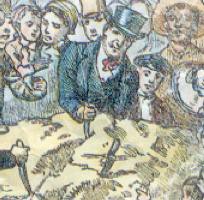
Early this afternoon we turned off the link to make donations to protestors in Madison, Wisconsin, because, yikes, there is only so much food and whatnots we can deliver! We were kind of expecting a few hundred dollars? Well…
Total donations, after fees taken: $2,272.46. This means pre-fee donations were around $2,340, so I donated $68.17 myself to eradicate them, so none of your kindly-given money is getting skimmed by Paypal. (Fun facts: smallest donation: $1.50; largest: $100. Average was probably around $12.)
Abe Sauer will report back from his (multiple and ongoing) shopping trips and deliveries to people demonstrating in Madison. He’s being joined by his brother and a few others that have emailed to help, and he’ll be sleeping in the Capitol tonight — and will keep making as many trips as it takes to deal with donations. It was suggested by some that we obtain 1400-pound blocks of cheese but uh… no. Gross. Things people have requested are: triangle bandages/cravats, yogurt, water dispensers, blankets, mats, pillows, coffee cups (but not Dixie brand), spreads/veggie dip, soft drinks, gluten-free stuff, hand sanitizer, cheese and cold cuts, fresh fruit and veggies, a spool or two of butcher paper, boxes of big magnum markers, sheets and a pre-paid smartphone for one of the organizers. So! Wow, and thanks, you awesome people!
Pretty Soon They Will Be Hauling Our Enormous Asses To The ER In Humvees
As was previously the case in Boston, emergency medical services — this time in Fort Worth, Texas — have been forced to expand the size of their ambulances to better accommodate our more corpulent frames. This is not so much news, but note the matter-of-fact tone of the the report: “Everybody’s tubbing up… and that’s the way it is.”
UPenn Students Mildly Inhospitable to Newt Gingrich
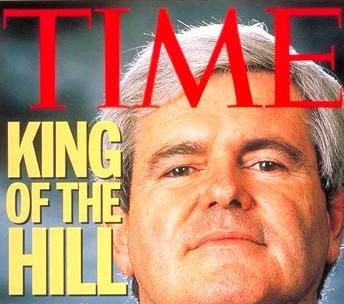
The editorial board of The Daily Pennsylvanian is extremely disappointed with its fellow students! You see, “A group of students stormed out of Irvine Auditorium in protest while [Newt] Gingrich was still speaking. One of them shouted as he left.” HOW UNCOUTH. What’s more? Someone called him a “salamander” and “some students hung posters of the politician’s face and some of his controversial quotes on doors of bathroom stalls and above urinals.” What in the world is going on at UPenn that these children are so remarkably measured and polite in their demonstrations against a visiting antisocial fraud-adoring grifter?
The Sad Lonely Whale
Meet the loneliest whale in the world: “Just imagine that massive mammal, floating alone and singing — too big to connect with most of the beings it passes, feeling paradoxically small in the vast stretches of empty, open ocean.” As a rotund, misunderstood person who also feels alone in a massive sea of humanity, this story has a particular resonance for me. [Via]
How to Spot a First Edition
One of the most touching things about Patti Smith’s memoir Just Kids is the way the author slips into book-scouting lingo when she describes the knack she had for that enjoyable (and revenue-enhancing) pastime in the late ’60s and early ‘70s:
Not long after, I found a twenty-six-volume set of the complete Henry James for next to nothing. It was in perfect condition. I knew a customer at Scribner’s who would want it. The tissue guards were intact, the gravures fresh-looking, and there was no foxing on the pages. I cleared over one hundred dollars. Slipping five twenty-dollar bills in a sock, I tied a ribbon around it and gave it to Robert.
Smith describes a number of such finds. The mere idea that you could run into a signed Faulkner just wandering around a used bookstore in New Jersey!
It’s worthwhile to know a little bit about rare books — because it’s fun and also because you shouldn’t be letting valuable things slip off into perdition, if you can help it. There are many characteristics that tend to make a book more valuable, but nearly all the valuable ones are first editions. So what is a first edition, exactly?
A reasonably simple question, but it turns out to be one of those deceptively difficult ones, like “What is knowledge?” or “Can cats secretly talk?”: one that even a lifetime of study can never fully answer.
Let’s get on a sound footing by first considering the whole idea of collecting books.
Bibliophilia, taken as a separate pursuit from the mere love of reading (which it may accompany) is concerned with all aspects of books, not only their contents. Bibliophiles like to study their materials and construction, or the whole history of a publishing house, a genre, an author. There’s no detail they won’t pore over. The history of publishing is chockablock with romantic stories: the charm and brilliance of designers like Eric Gill, say, or the literary sensitivity of Max Perkins (soon to be played by Sean Penn in a movie, apparently). Whole collections are built around such things as these. And collectible books can become tokens rich with personal associations, of course. Patti Smith found one of the rare Ace paperbacks of William S. Burroughs’s debut as “William Lee” at a bookstall near Forty-Second Street one night with Robert Mapplethorpe. She never sold it, she says.
The study of a particular copy will somehow set the collector’s heart beating a little faster: how close is it to that rare state, “pristine,” still looking absolutely new despite its great age, in a fresh, glossy, clean wrapper free of even the slightest little tear, and inscribed by the author to his favorite mistress, who happens to be the model for the heroine of the story? That would be ideal. Or maybe it’s an agreeably raggedy old thing, published by the book club a century later: “spine ends bumped, with chipped corners, cocked, hinges cracked and some foxing.”
For those of us who have always collected books in order to read them, the two might scarcely be worth telling apart, so long as they contain the same words in the same order. To a collector, however, who sees each copy of a book as a specific, significant instance of that book’s history on this earth, the difference may be as vast as that between the Hope Diamond and some wretched thing the cat dragged in. So, on to business.
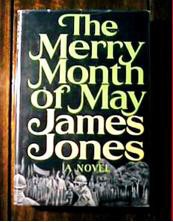
Here is a quite nice-looking book, in a decent dustjacket (or in Knifecrime Islandese, “dustwrapper”) in a protective mylar cover. (The Highsmith company of Wisconsin is a great library supplier where you can buy these at a good price and in small quantities. Yay Wisconsin.)
Much of the information you’ll need for identifying a first edition is contained on the copyright page, which can be found on the reverse side (“verso” they sometimes say) of the title page.
The number series (also “number line” or “printer’s key”) found on the copyright page of many modern books is a valuable clue. Unfortunately, the subject volume lacks this feature. When the number “1” is present, that is an excellent sign and really almost always means a first printing. Irritatingly, some publishers such as Random House (in certain years) omit the “1” and begin with “2,” even on the first printing.
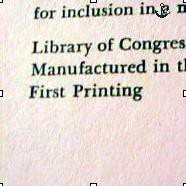
If you’re lucky, you will see the generally credible words, “First Printing.” A first printing in collector’s terms means the first printing of the first edition, so that when you see those words your research may well be over. The words “first edition” and “first printing” are often used more or less interchangeably in the book world, though really they shouldn’t be. A printing is a single print run. An edition refers to the whole set of what were once printing plates. When any corrections or amendments are made to the original plates, then you have a second edition. If a dozen separate printings are made off the first set of plates, though, only those copies from the very first printing are of significant value; this is true, generally speaking, even of highly collectible books. You may have the twelfth printing of the first edition, but that doesn’t mean you have a “true first.” Almost always, it’s only the very first printing that has collectible value. (With older books, this whole business gets quite a bit trickier, since number lines didn’t come into general use until well into the twentieth century. It sometimes takes quite a bit of research to get hold of all the pertinent details.)
The agreeable term “First Printing” can also be found occasionally in a modern book club edition, in which case the book club will have just ordered some immense number of copies right off the first print run.
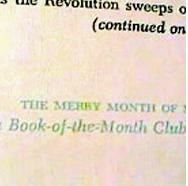
This very book contains a message indicating that it was a selection of the Book-of-the-Month Club. That may mean that this is a book club edition, printed in the zillions and therefore utterly without value; or it may mean that the author Mr. Jones was fortunate enough to have secured an agreement with the BOMC in advance of the original trade publication of his novel. In these cases, you must check out the dustjacket, if present. Book club editions, most commonly, do not have a price on the inner flap of the dustjacket. But this copy has the price… a good sign.
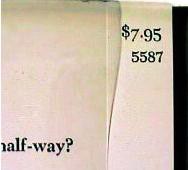
Also, you’ll find that book-club editions are commonly marked with a blind stamp — that’s a small embossed dot or square or other recessed mark on the lower right corner of the back cover. There are probably exceptions to this (there always seem to be!), but blind stamps seem to be found only on book club editions. No blind stamp here … excellent.
(Personally, I find book club editions make great reading copies, and you don’t have to feel so guilty when you take them into the bathtub.)
It’s a good bet that this is, in fact, a genuine first edition. Worth, according to comparisons from the various search services such as Abebooks, maybe thirty or forty bucks in this condition.
The real trouble is that even today, there are no standards by which all publishers routinely identify their own first editions, and there are immense numbers of publishers. Not to mention which, publishing houses tend to change their methods over the years, and exceptions and errors are made constantly. Even experts are continually fooled as to the authenticity of various books purported to be “firsts.” All the little details that go into identifying the first edition of a particular title are called “points,” or “points of issue”; if you ever get into collecting a particular set of titles, you’ll very soon be up on all the relevant ones. Here’s a good one, just to be getting on with: the true first of Infinite Jest has got William Vollmann’s name misspelled on the dustjacket blurb (with just one “n”).
Keep in mind too that most books, even most first editions, are without collectible value. Only the stuff that turns out to have lasting interest appreciates over time. Really the best way to learn how to identify valuable first editions is to handle a lot of books with a view to learning how to do so. There are several excellent basic books on collecting commonly used by experts, notably Collected Books: The Guide to Values by Allen Ahearn and Patricia Ahearn, and The Pocket Guide to the Identification of First Editions by Bill McBride is a good portable reference. Also recommended: the murder mysteries by John Dunning, Booked to Die and The Bookman’s Wake. These feature the detective Cliff Janeway, a bibliophile and book dealer whose descriptions of book collecting are fun to read and full of useful details. Plus, there are murders!
Please be aware that a substantial percentage of the books for sale online are wrongly described. (That is a knife that cuts both ways, of course, because quite often less knowledgeable sellers may not quite know what it is they’ve got.) Careful study will reveal that many, many dealers, in some cases more than half those offering a given title, have not bothered to figure out what the earliest printing was, but instead merely pop the magic words “first edition” into their listings, either out of unwarranted optimism or mere laziness, or outright chicanery. If book lovers do the necessary homework, it will no longer pay those lazy bums to be so sloppy.
A Visual Dictionary of Commonly Used Terms
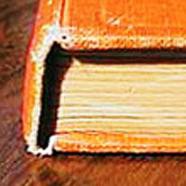
Cocked (spine slanted)
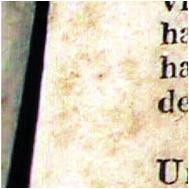
Foxing

A blind stamp
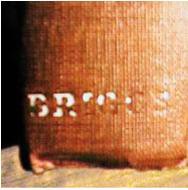
Lower spine end bumped
Maria Bustillos is the author of Dorkismo and Act Like A Gentleman, Think Like A Woman.
"Unruly Man" Troubles Yale Youngsters!
“A Hamden, Conn., resident rapped about his genitalia and struggled with police officers, drawing a crowd on Cross Campus Tuesday morning.”
— Oh indeed yes. And? “’It was kind of scary because I hadn’t seen something like that incident before in New Haven,’ Kavita Kapadia ’13 said.” Ugh, KIDS TODAY.
20 People to Follow on Twitter: @DogsDoingThings
Dogs bullhorn-orating from atop World Trade Center wreckage, “Bring the revolution home, kill your parents; that’s where it’s really at!”less than a minute ago via web
Dogs doing things
dogsdoingthings
I can’t really explain this, nor would I want to! It’s not really comedy? It’s not really tragedy either though. OR IS IT. (Previously.)
Our Unfocused Youth Lack Sophisticated Pickpocketing Skills
Kids today: “’Pickpocketing is a subtle theft,’ says Jay Albenese, a criminologist at Virginia Commonwealth University. ‘It requires a certain amount of skill, finesse, cleverness, and planning, and the patience to do all that isn’t there’ among American young people. This is ‘a reflection of what’s going on in the wider culture,’ Albenese says.” [Via]
